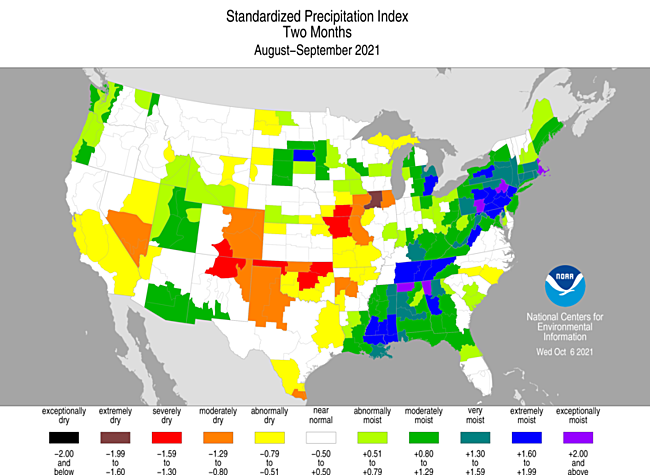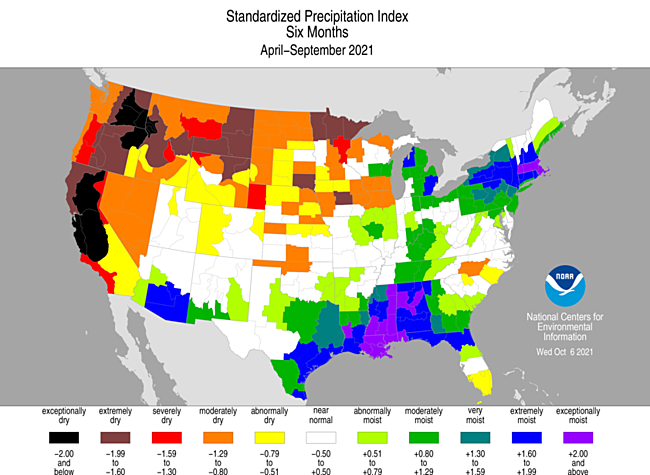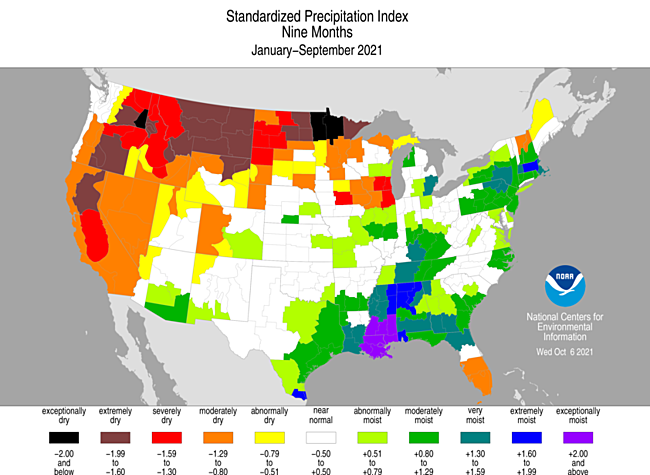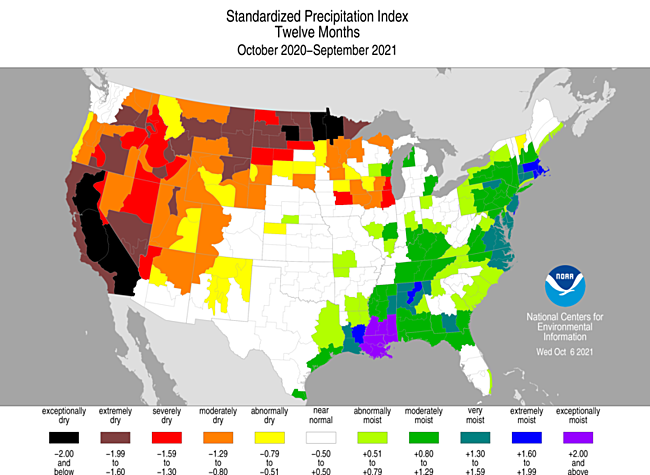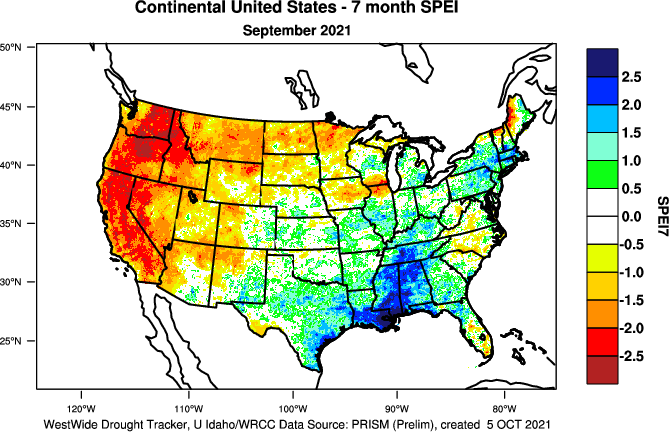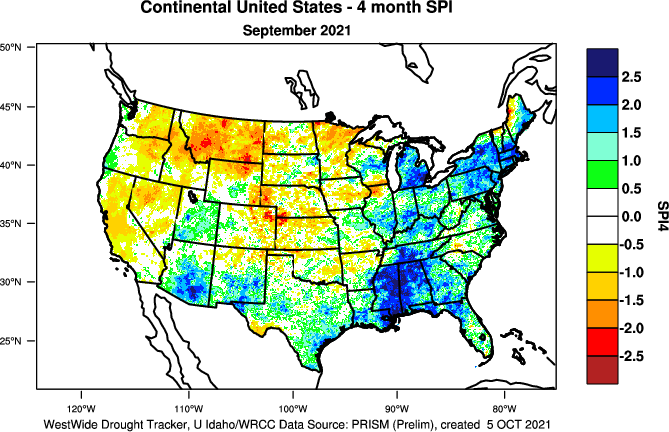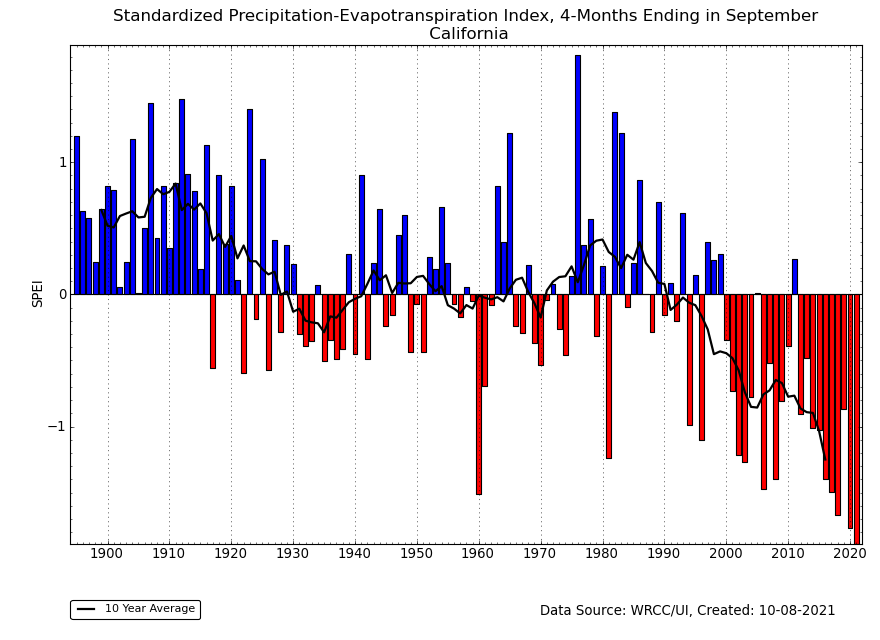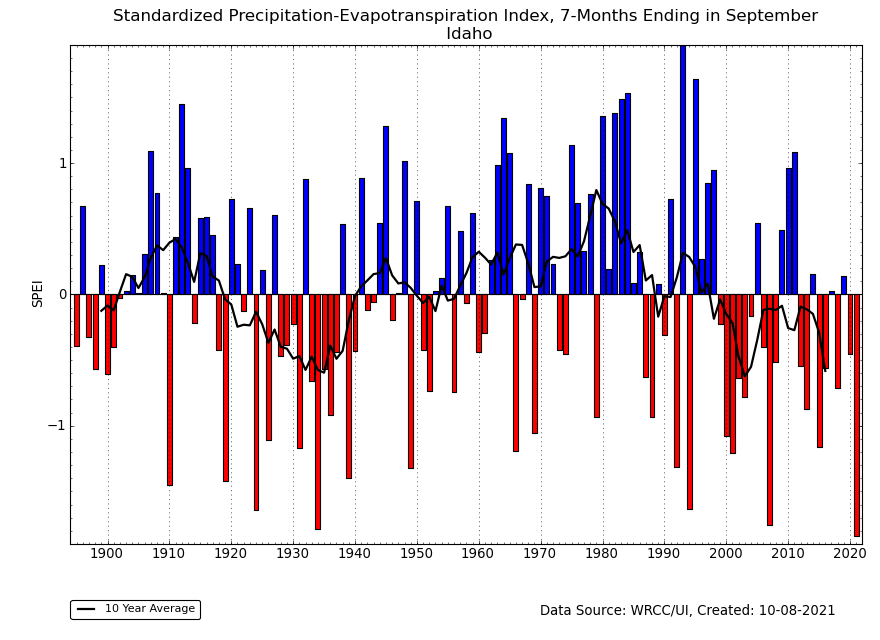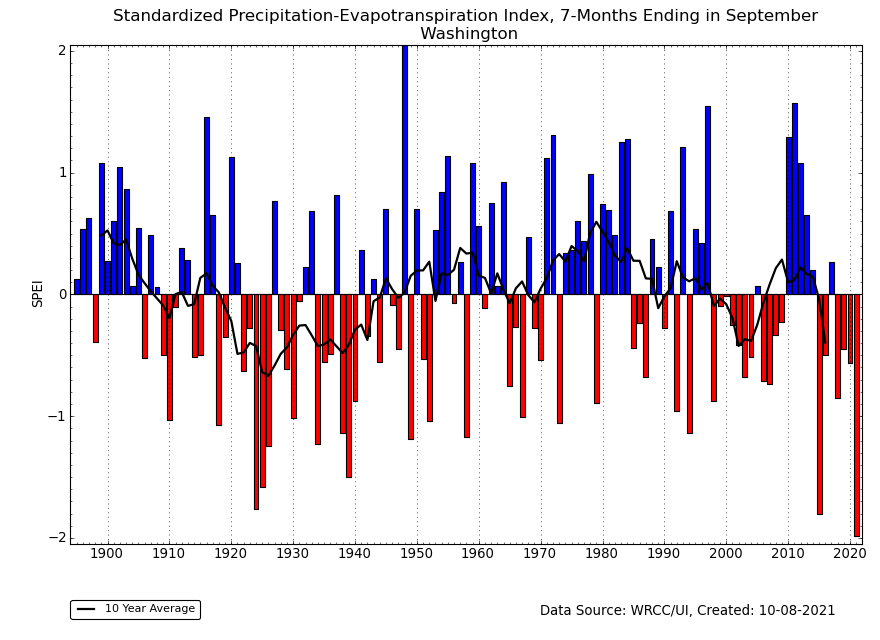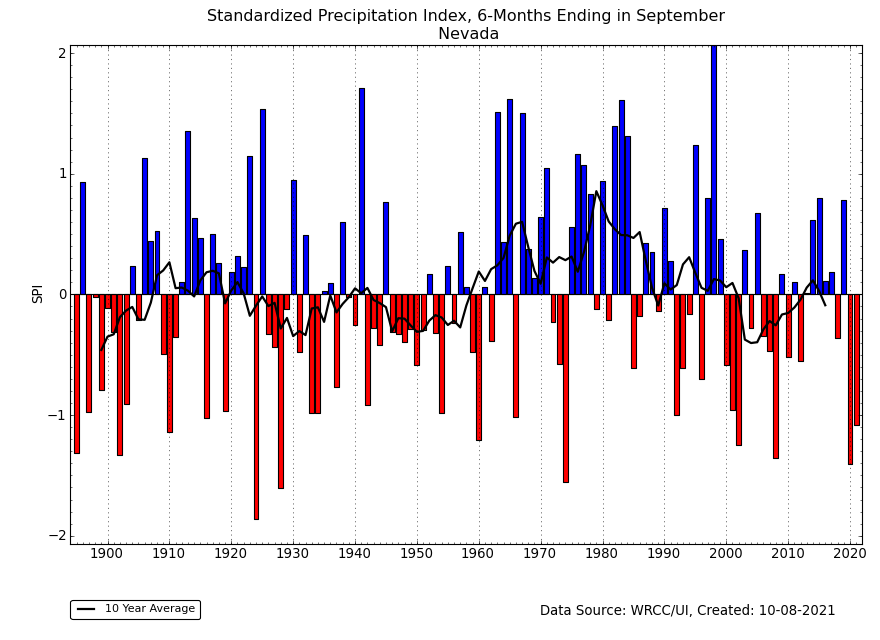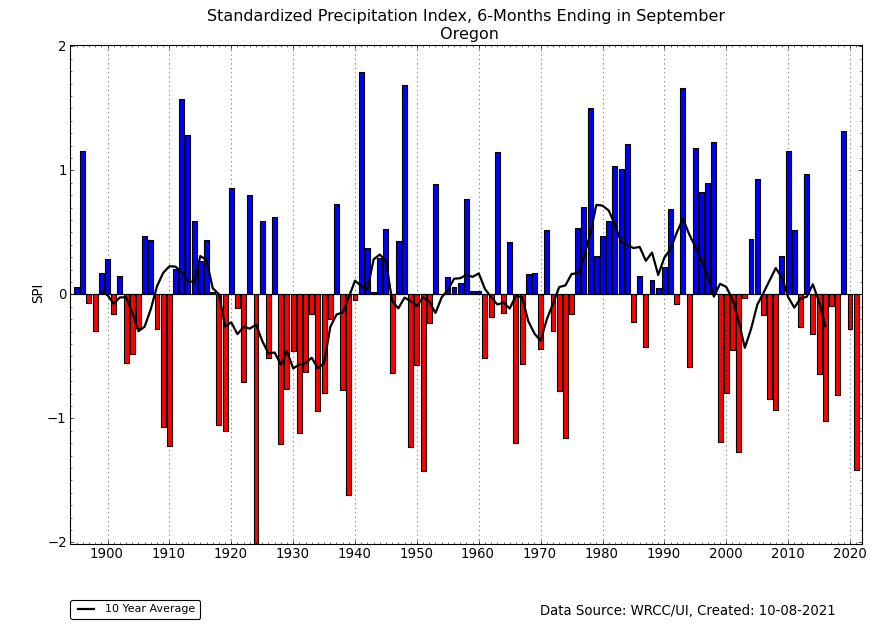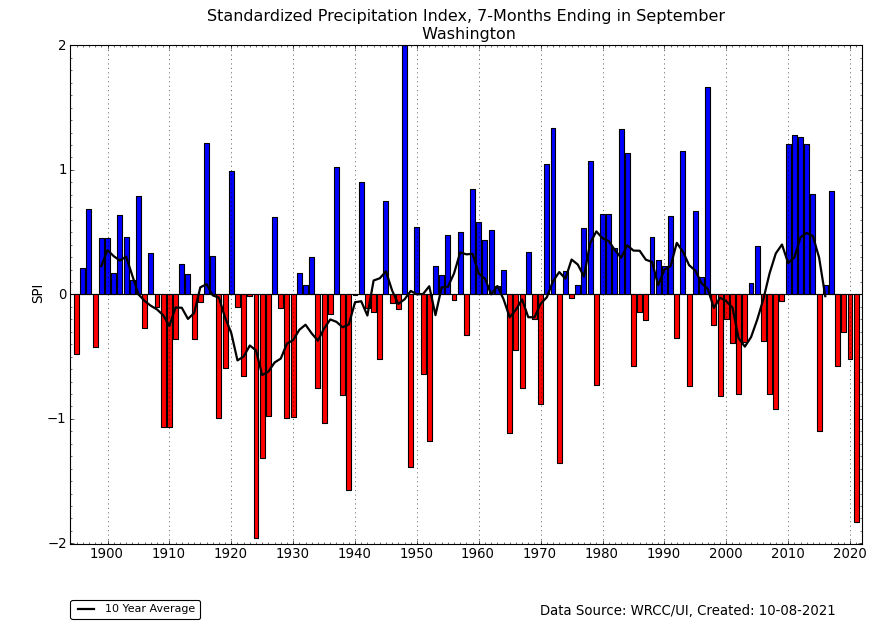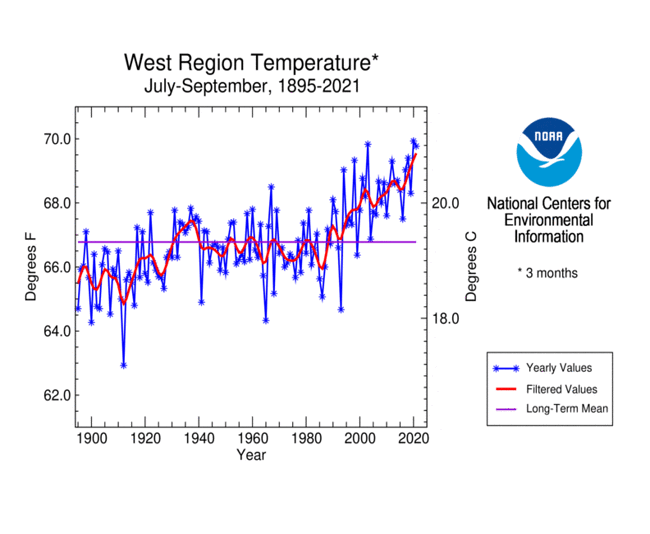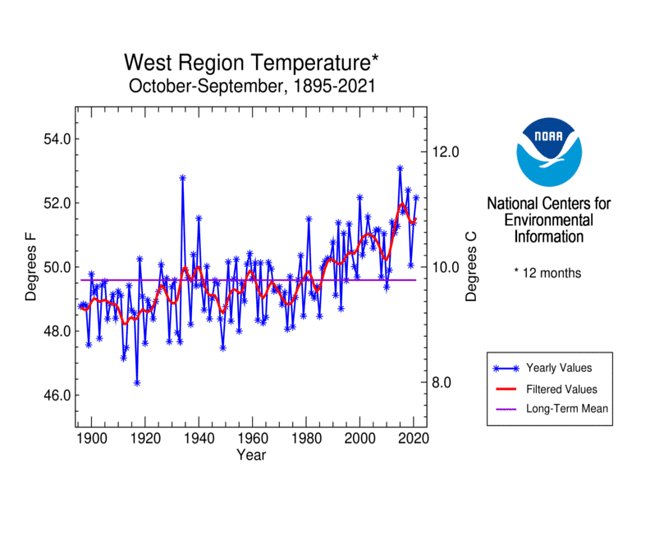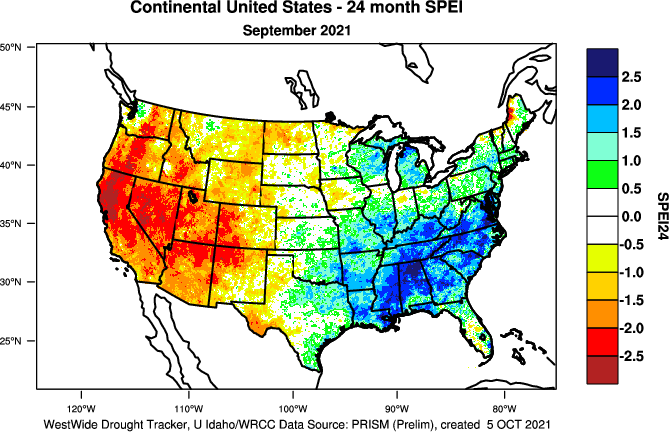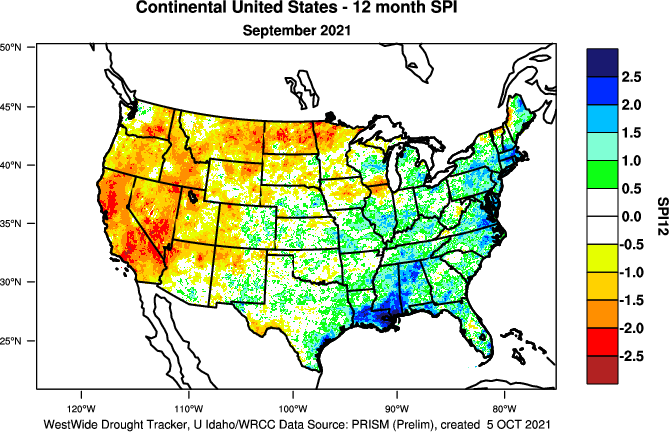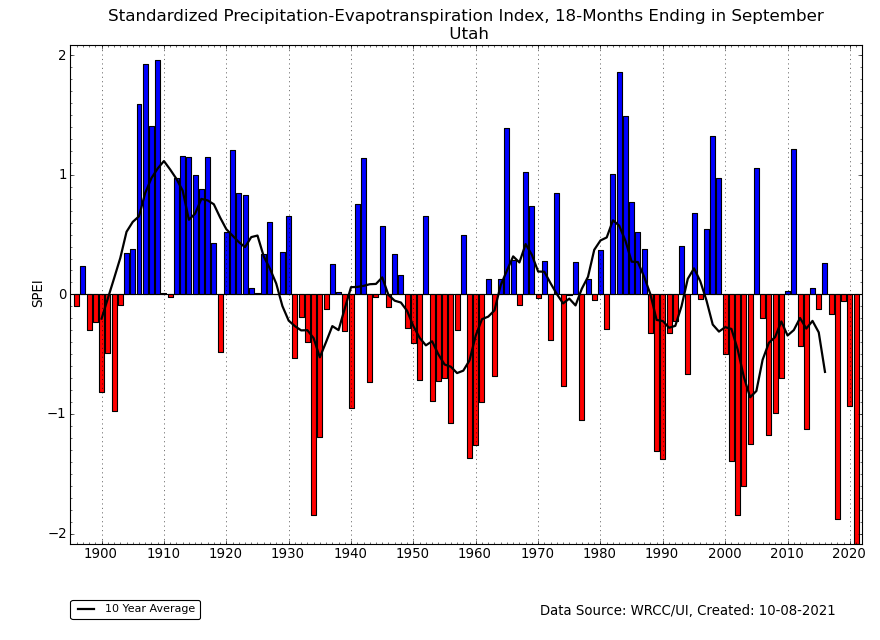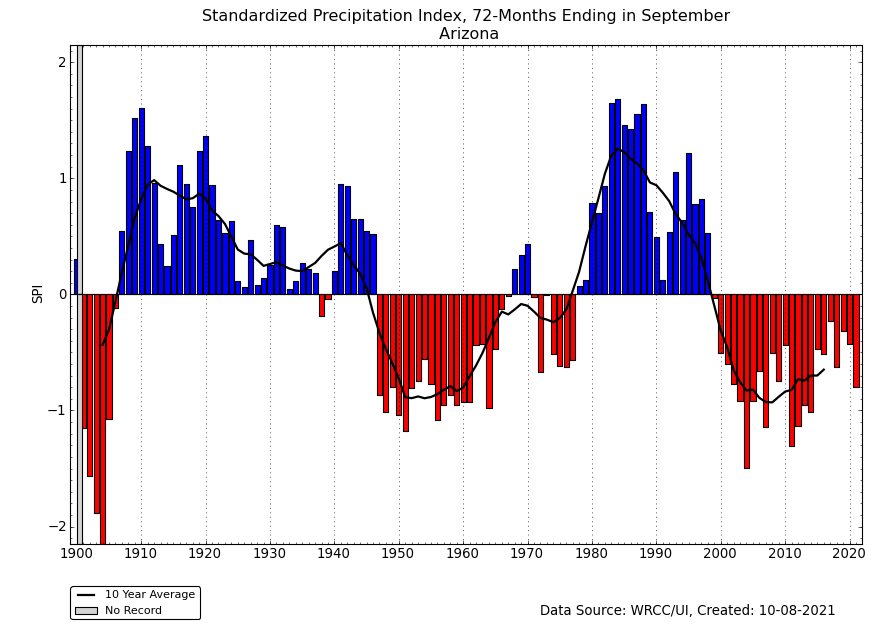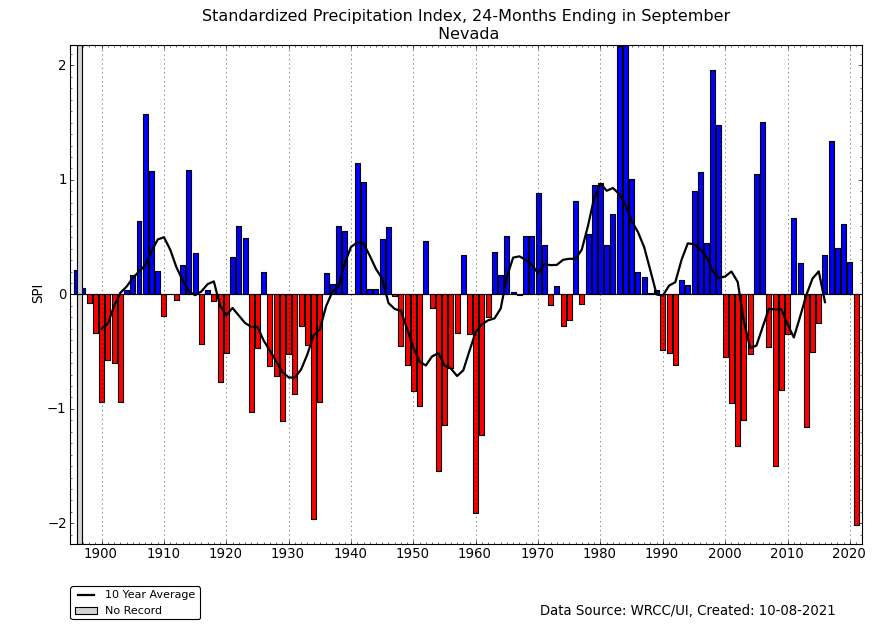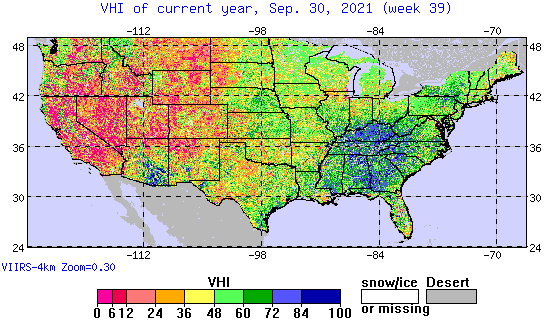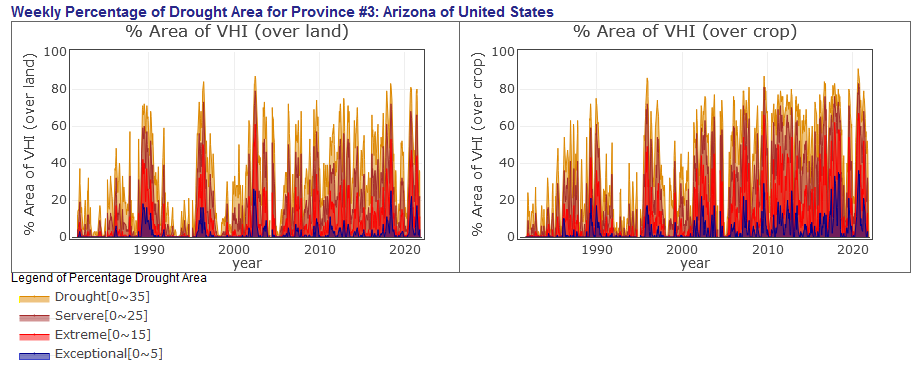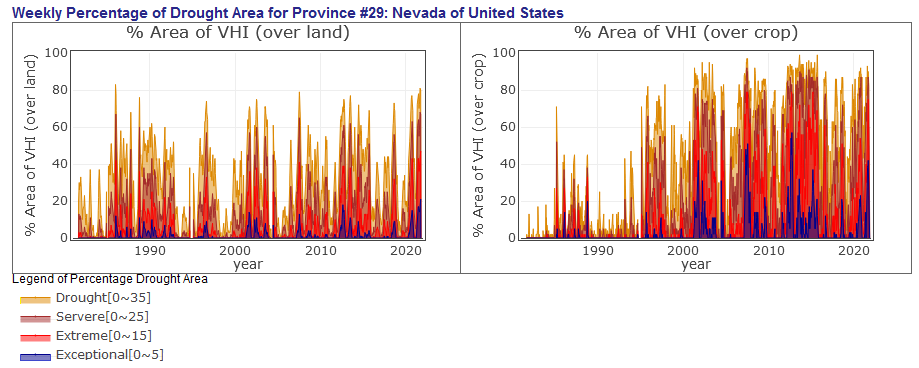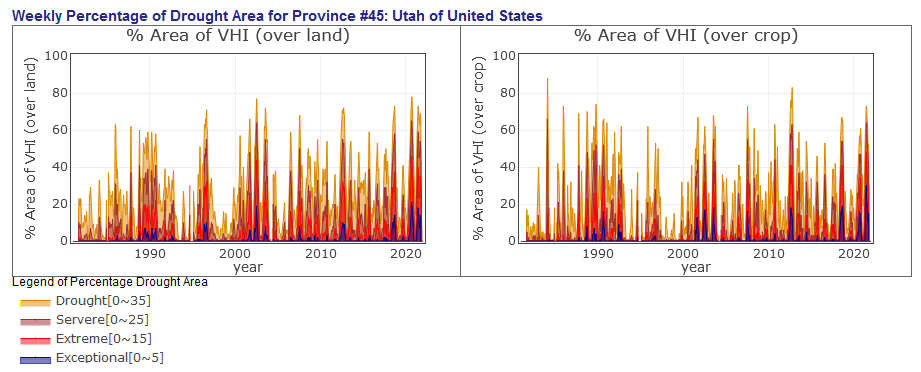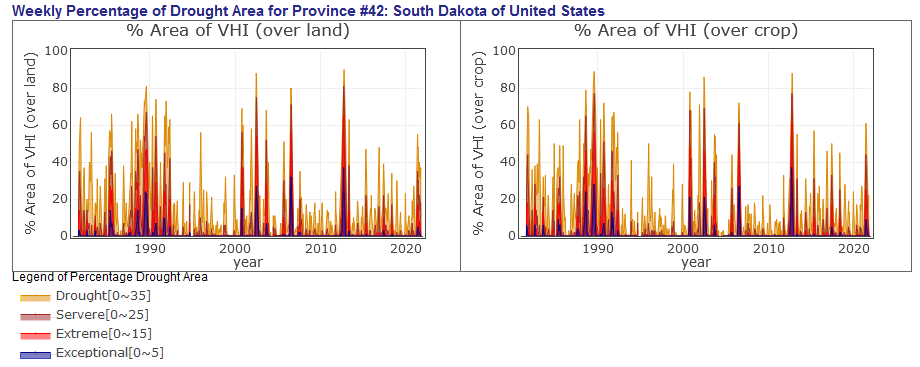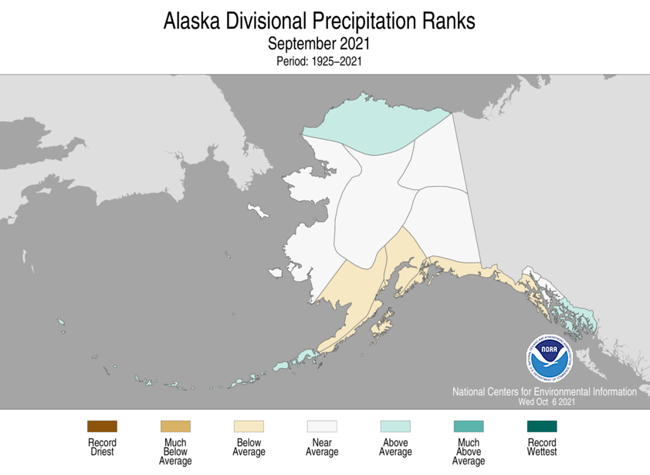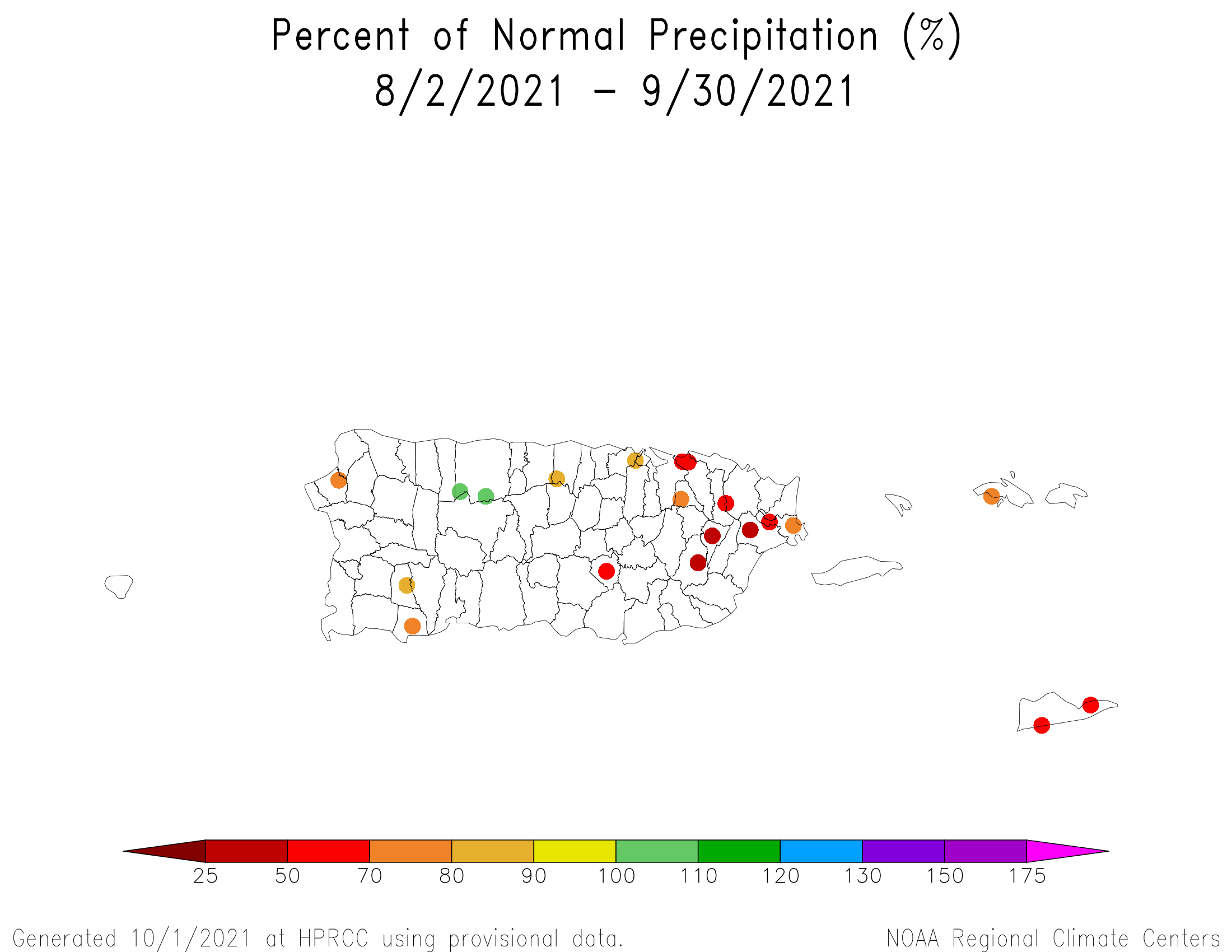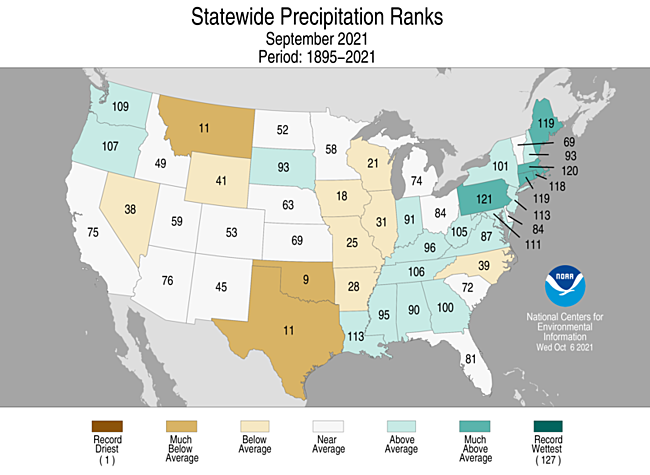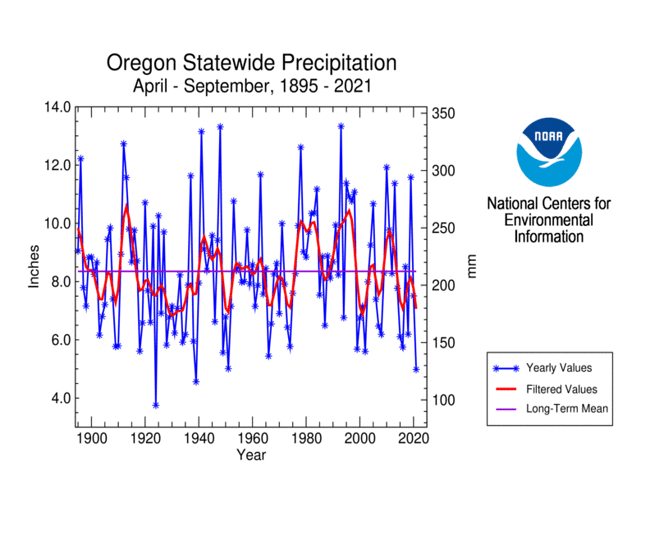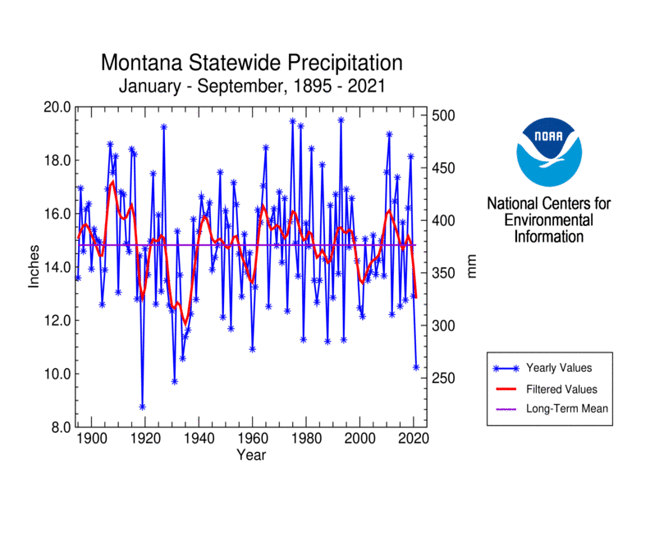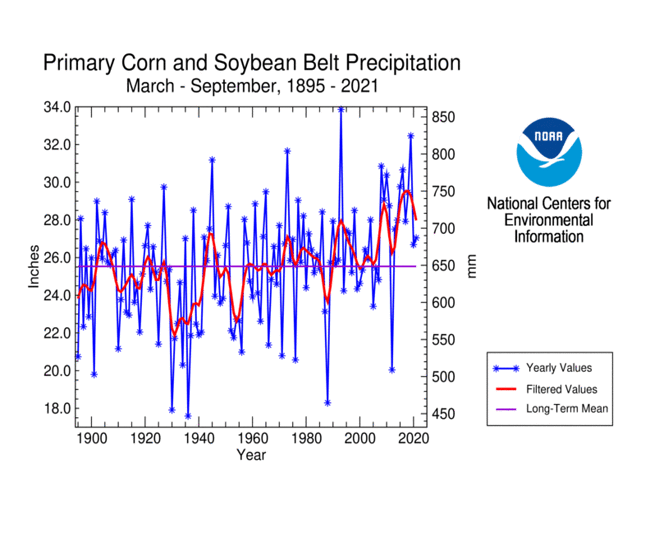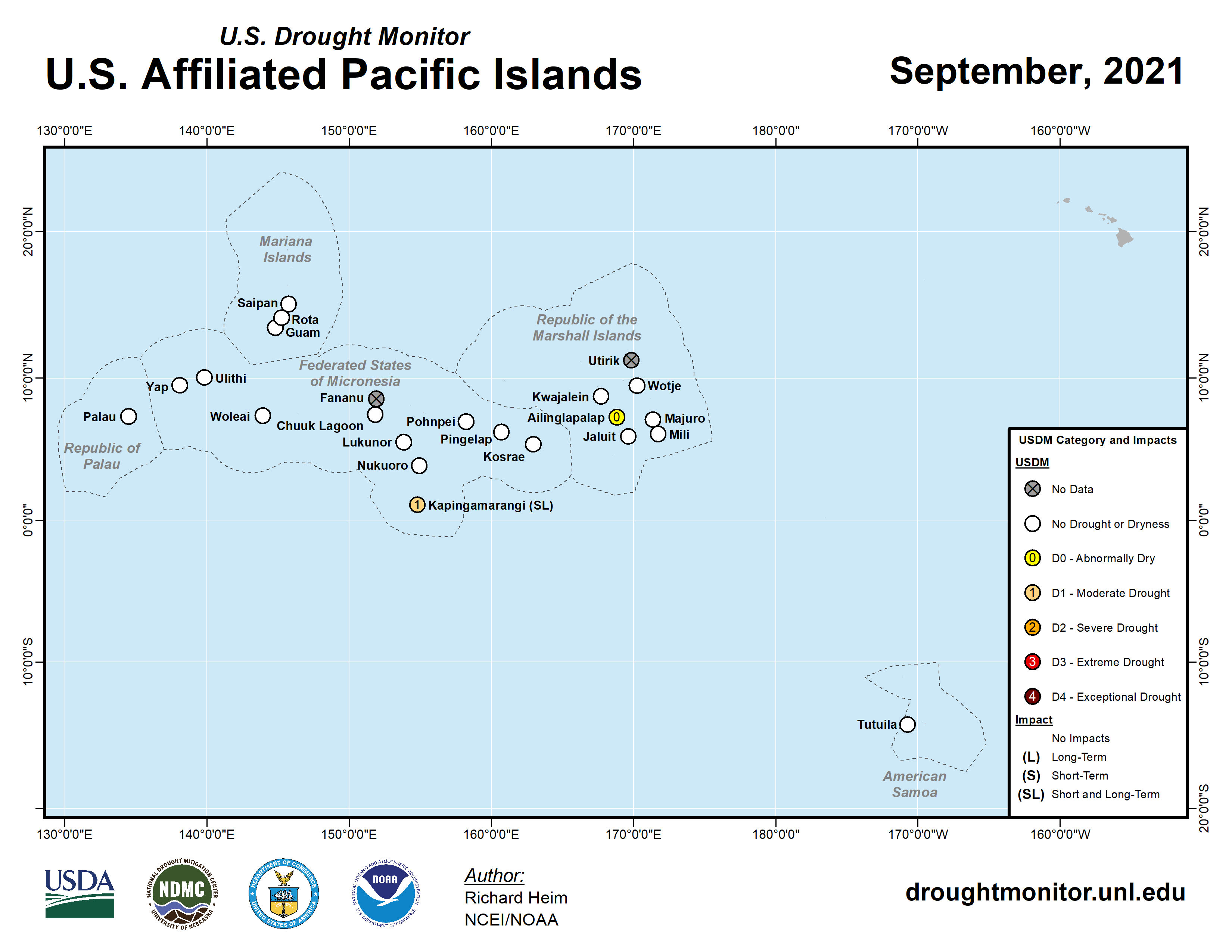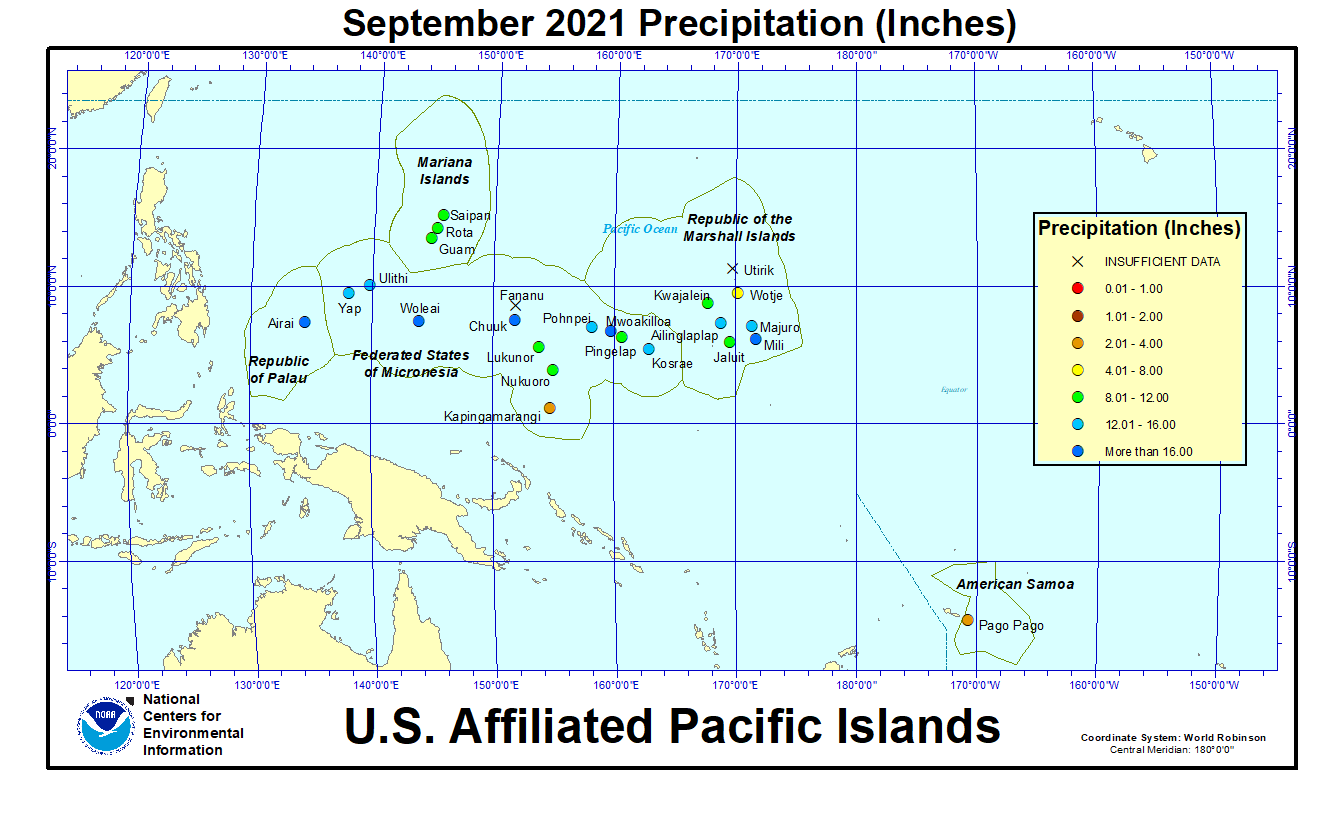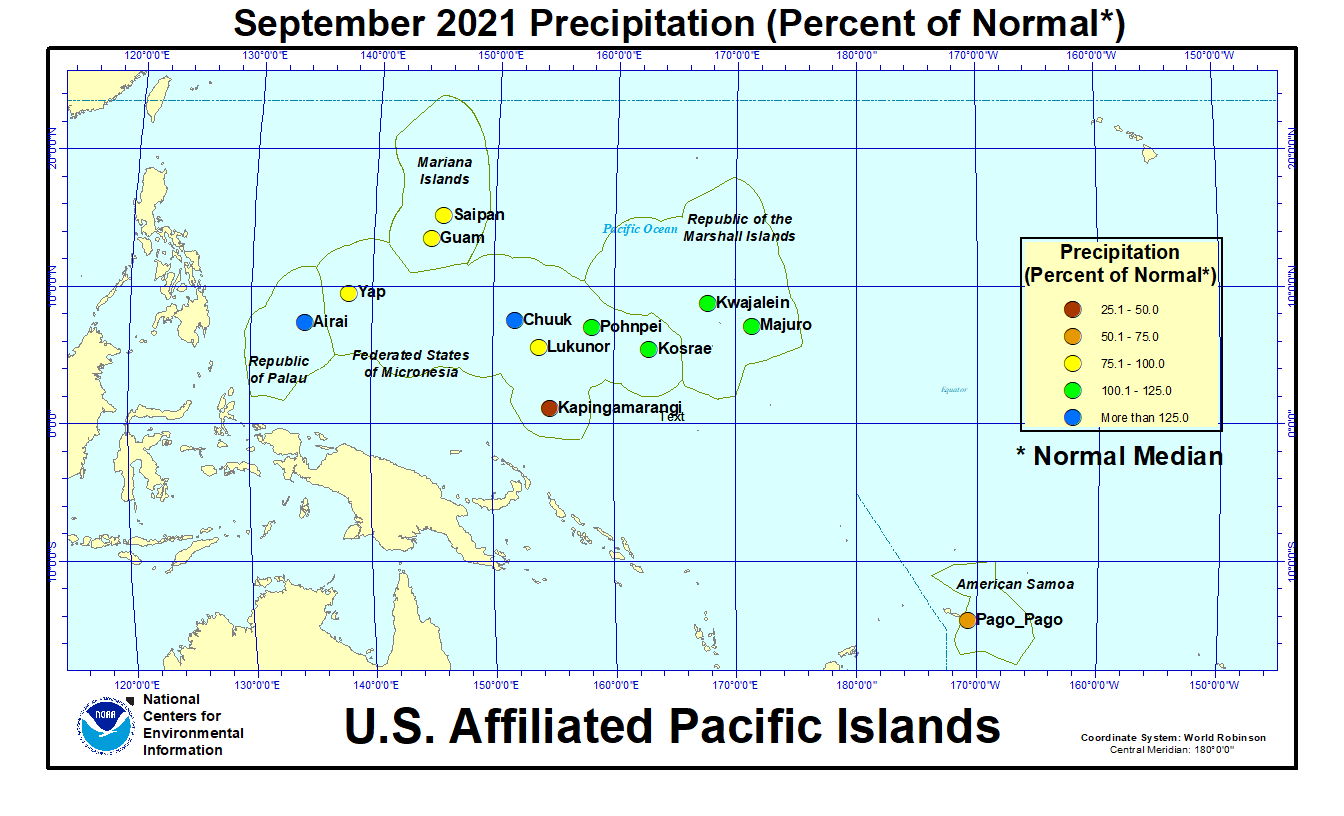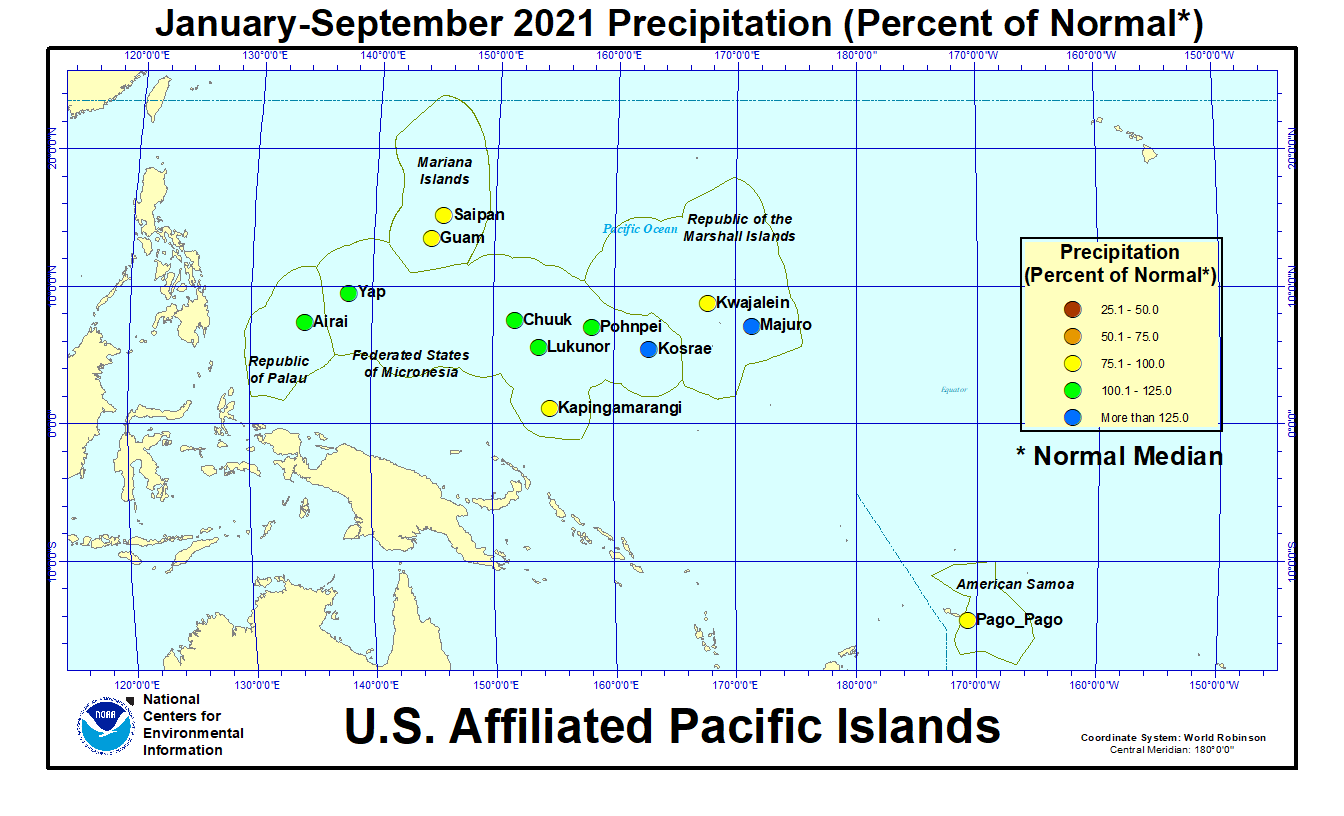Issued 13 October 2021
Please note that the values presented in this report are based on preliminary data. They will change when the final data are processed, but will not be replaced on these pages.
National Drought Highlights
- Based on the Palmer Drought Index, severe to extreme drought affected about 35% of the contiguous United States as of the end of September 2021, about the same as last month. About 12% of the contiguous U.S. fell in the severely to extremely wet categories.
- About 45% of the contiguous U.S. fell in the moderate to extreme drought categories (based on the Palmer Drought Index) at the end of September.
- On a broad scale, the 1980s and 1990s were characterized by unusual wetness with short periods of extensive droughts, the 1930s and 1950s were characterized by prolonged periods of extensive droughts with little wetness, and the first two decades of the 2000s saw extensive drought and extensive wetness (moderate to extreme drought graphic, severe to extreme drought graphic).
- A file containing the national monthly percent area severely dry and wet from 1900 to present is available for the severe to extreme and moderate to extreme categories.
- Historical temperature, precipitation, and Palmer drought data from 1895 to present for climate divisions, states, and regions in the contiguous U.S. are available at the Climate Division: Temperature-Precipitation-Drought Data page. These filenames begin with "climdiv".
- According to the weekly U.S. Drought Monitor (USDM), as of September 28, 2021, 47.84% of the contiguous U.S. (CONUS) (40.05% of the U.S. including Alaska, Hawaii, and Puerto Rico) was classified as experiencing moderate to exceptional (D1-D4) drought.
Detailed Drought Overview
The upper-level circulation during September 2021 generally consisted of a jet stream which was located near the U.S.-Canadian border and high pressure ridging across the southern tier states. Shortwave troughs and ridges migrated through the jet stream flow, with troughs and a few closed lows occasionally penetrating into the southern states. The upper-level troughs dragged Pacific cold fronts at the surface, with some of them reaching the Gulf of Mexico coast. The migratory nature of the short-wave troughs and ridges caused the long-wave pattern to shift throughout the month, resulting in a monthly circulation pattern consisting of an anomalous ridge over the Rockies and Plains with slight troughing along the west and east coasts. This pattern was associated with warmer-than-normal temperatures across the Plains to Southwest and extending into the Northeast. The dominant ridging kept precipitation below normal across much of the CONUS, except for northern California to Washington state where Pacific weather systems brought above-normal precipitation and, for Oregon and Washington, near-normal temperatures. Fronts and upper-level troughs and lows brought areas of above-normal precipitation to parts of the Southwest, central to northern Plains, and Midwest, but the precipitation pattern was complicated by several tropical systems that spread rain across parts of the Gulf coast to Northeast.
As a result of these conditions, drought or abnormal dryness expanded or intensified in much of the southern Plains and parts of the central Plains, Midwest, and West. Beneficial precipitation caused drought or abnormal dryness to contract or decrease in intensity in parts of the Southwest, Pacific Northwest, central and northern Plains to Upper Midwest, central Appalachians, and New England. Drought expansion exceeded contraction for the CONUS with the USDM-based national moderate-to-exceptional drought footprint increasing from 46.6 percent at the end of August to 47.8 percent at the end of September (from 39.0 percent to 40.1 percent for the 50 States and Puerto Rico). According to the Palmer Drought Index, which goes back to the beginning of the 20th century, about 44.7 percent of the CONUS was in moderate to extreme drought at the end of September, an increase when compared to the end of August. The percent area of the CONUS in moderate to extreme drought has hovered between 35 and 48 percent for the last 13 months (since September 2020).
Drought conditions at the end of September, as depicted on the September 28, 2021 USDM map, included the following core drought and abnormally dry areas:
- Moderate (D1) to extreme (D3) drought extended from the West Coast to Rocky Mountains and into the adjacent northern Plains, with a large areas of exceptional (D4) drought. The severity and expanse of the drought was reflected in low streamflow (USGS), groundwater (USGS, GRACE), and reservoir (California, westwide) levels; dry soils (CPC, NLDAS, USDA/NASS, SMOS, GRACE root zone and surface); parched vegetation (QuickDRI, VegDRI); and widespread large wildfires (wildfire maps for September 1, 8, 14, 20, 25, 30). The percent area of the West experiencing moderate to exceptional drought, according to USDM statistics, hovered around 90 percent, decreasing slightly from 89.9 percent at the end of August to 89.6 percent at the end of September. The percent area of the West (from the Rockies to the West Coast) in moderate to extreme drought (based on the Palmer Drought Index) also hovered around 90 percent, with a value of 89.7 percent at the end of September 2021.
- Drought reduced in intensity in some parts of the central to northern Plains but expanded in the southern Plains. The moderate to exceptional drought area expanded from 61.3 percent of the central and northern Plains at the end of August to 63.6 percent at the end of September. In the southern Plains, moderate to extreme drought ballooned from 10.8 percent at the end of August to 26.5 percent at the end of September, with the greatest expansion and intensification occurring in Oklahoma which had the ninth driest and 13th warmest September on record. The drought conditions were reflected in low groundwater (GRACE) levels; dry soils (CPC, NLDAS, USDA/NASS, SMOS, GRACE root zone and surface); and parched vegetation (QuickDRI, VegDRI).
- Drought expanded in some parts of the Midwest and contracted in others, with exceptional drought disappearing. Overall, the moderate to extreme drought area contracted from 24.5 percent at the end of August to 23.4 percent at the end of September. The worst drought areas were in the western Great Lakes and Upper Mississippi Valley.
- Moderate to severe drought contracted in the Northeast, shrinking from 12.1 percent at the end of August to 3.1 percent at the end of September.
- In the Southeast, moderate drought disappeared and abnormal dryness shrank from 4.8 percent (in moderate drought and abnormal dryness) at the end of August to 2.5 percent (abnormally dry) at the end of September.
- Moderate to extreme drought continued in Hawaii, but the overall drought footprint shrank from 40.1 percent at the end of August to 38.5 percent at the end of September.
- In the Caribbean, moderate drought grew from 4.1 percent of Puerto Rico at the end of August to 11.8 percent at the end of September. Drought conditions were unchanged in the U.S. Virgin Islands (USVI) compared to last month, with moderate drought continuing in the south on St. Croix and abnormal dryness on St. John in the north, while St. Thomas remained free of drought and abnormal dryness.
- In the U.S.-Affiliated Pacific Islands (USAPI), compared to last month, moderate drought developed on Kapingamarangi (in the Federated States of Micronesia), but Ailinglaplap in the Marshall Islands improved to abnormally dry and Jaluit, Kwajalein, Wotje, and Chuuk became free of drought and abnormal dryness. The rest of the USAPI remained free of drought or abnormal dryness.
Palmer Drought Index
The Palmer drought indices measure the balance between moisture demand (evapotranspiration driven by temperature) and moisture supply (precipitation). The Palmer Z Index depicts moisture conditions for the current month, while the Palmer Hydrological Drought Index (PHDI) and Palmer Drought Severity Index (PDSI) depict the current month's cumulative moisture conditions integrated over the last several months. While both the PDSI and PHDI indices show long-term moisture conditions, the PDSI depicts meteorological drought while the PHDI depicts hydrological drought. The PDSI map may show less severe and extensive drought (as well as wet spell conditions) in some parts of the country than the PHDI map because the meteorological conditions that produce drought and wet spell conditions are not as long-lasting as the hydrological impacts.
Used together, the Palmer Z Index and PHDI maps show that short-term drought occurred across the northern Plains to northern Rockies, Great Basin, and parts of the Southwest and southern High Plains. In these areas, long-term drought continued, intensified, or expanded (PHDI maps for September compared to August). Short-term drought also occurred across the southern Plains, central Plains to western Great Lakes, and parts of the coastal Carolinas. In these areas, long-term drought expanded or intensified (Iowa, Illinois, and Upper Michigan) or long-term wet conditions decreased in intensity or contracted (southern Plains, Wisconsin, coastal Carolinas). Short-term wet conditions in the Northeast decreased the intensity of long-term drought in northern New England, and short-term wet conditions from the Lower Mississippi Valley to southern New England led to expansion, intensification, or introduction of long-term wet conditions.
Standardized Precipitation Index
The Standardized Precipitation Index (SPI) measures moisture supply. The SPI maps here show the spatial extent of anomalously wet and dry areas at time scales ranging from 1 month to 24 months.
The SPI maps illustrate how moisture conditions have varied considerably through time and space over the last two years. In the West, this year's summer monsoon resulted in near-normal to wet conditions across much of the region for the last 1 to 3 months, with patches of dryness in the northern Rockies at 1 and 3 months and Great Basin to California at 1 to 2 months. The Southwest has some near normal to wet conditions at 6 and 9 months, but otherwise the West has widespread dryness from 6 to 24 months. Parts of the northern Plains are dry at 1 and 3 months, with widespread dryness at 6-24 months. Parts of the central Plains are dry at 1-24 months, especially the central High Plains at the longer time scales. Parts of the western Great Lakes and Mid- to Upper Mississippi Valley are dry at all time scales. The southern Plains are dry at the 1-month time scale, with the dry area contracting at 2 to 3 months, and dryness reappearing in the southern High Plains at 24 months. Parts of the Carolinas are dry at 1 to 2 months and 6 months, while southern Florida and northern New England are dry at 9 months. Wet conditions dominate much of the Gulf of Mexico coast to southern New England at all time scales, the coastal Northwest at 1 to 2 months, parts of the Southwest at 2 to 9 months, and parts of the northern Plains to Great Lakes at 1 to 6 months. An interesting pattern is evident at the 12- and 24-month time scales — very dry conditions dominate across the West to northern Plains, while very wet conditions dominate the Deep South to Atlantic Coast.
Standardized Precipitation Evapotranspiration Index
The SPI measures water supply (precipitation), while the SPEI (Standardized Precipitation Evapotranspiration Index) measures the combination of water supply (precipitation) and water demand (evapotranspiration as computed from temperature). Warmer temperatures tend to increase evapotranspiration, which generally makes droughts more intense.
For the Northern Hemisphere, September marks the beginning of climatological autumn, which is the transition season from the warmest season of the year (summer, when evapotranspiration reaches its annual maximum) to the coldest season (winter, when evapotranspiration is minimal). During September 2021, temperatures were above normal across most of the West, Great Plains, and Great Lakes to Northeast, with some isolated areas of record warmth. This resulted in increased evapotranspiration which led to a more severe SPEI than SPI where precipitation was below normal. Much of the year was warmer than normal in the West, especially beginning in June but also in some areas back to April. Record-warm temperatures occurred for the last 3 to 6 months, and several western states had a record warm April-September. With evapotranspiration above normal (EDDI maps for the last 1, 2, 3, 4, 5, 6, 7, 8, 9, 10, 11, 12 months), the SPEI was more extreme than the SPI in these hot dry areas for most of the year (SPEI maps for last 1, 2, 3, 4, 5, 6, 7, 8, 9 months) (SPI maps for last 1, 2, 3, 4, 5, 6, 7, 8, 9 months), especially over the West and northern Plains.
The SPEI was record dry for several states for several of the time periods over the last one to 12 months. In many cases, the corresponding SPI was not record dry:
- California (SPEI for last 4, 5, 6, 7, 8, 9, 10, 11, 12 months) (SPI for last 4, 5, 6, 7, 8, 9, 10, 11, 12 months)
- Idaho (SPEI for last 4 and 7 months) (SPI for last 4 and 7 months)
- Nevada (SPEI for last 4, 5, 6 months) (SPI for last 4, 5, 6 months)
- Oregon (SPEI for last 5, 6, 7 months) (SPI for last 5, 6, 7 months)
- Washington (SPEI for last 7 months) (SPI for last 7 months)
Temperatures have been much warmer than normal in the Western U.S. for much of the last one to eight years.
Precipitation has also been drier than normal for much of this period.
The excessive evapotranspiration, especially during the warm season, has contributed to more extreme SPEI values than SPI values for much of this period (SPEI maps for the last 12, 24, 36, 48, 60, 72 months) (SPI maps for the last 12, 24, 36, 48, 60, 72 months).
The above-normal Southwest monsoon rains of this summer have helped make up deficits in the short term, but significant long-term deficits still remain. Many multi-year SPEI values, and some multi-year SPI values, are still record dry for several states:
- Arizona (SPEI for last 15, 18, 72 months) (SPI for last 15, 18, 72 months)
- California (SPEI for last 15, 18, 24 months) (SPI for last 15, 18, 24 months)
- Nevada (SPEI for last 15, 18, 24 months) (SPI for last 18, 24 months)
- Utah (SPEI for last 18 months) (SPI for last 18 months)
Vegetation Health Index
The NOAA Center for Satellite Applications and Research (STAR) creates products that show the health of vegetation as observed from orbiting satellites. The satellites measure energy intensities at various wavelengths. The health of vegetation is reflected in the intensities of energy they emit at certain wavelengths. The products created from this data can be used as proxies for monitoring vegetation health; drought; soil saturation; and moisture, thermal and other conditions.
The Vegetation Health Index (VHI) and Stressed and Healthy Vegetation maps show vegetation that is in poor condition across most of the West and western portions of the Great Plains. This is also reflected in the Vegetation Condition Index (VCI), Moisture Stress, and Drought-Related Risk maps.
The percent area of a state's vegetation that is experiencing drought has been calculated from this data over the period 1982-present. Time series that show the percent area of vegetation (based on the VHI) experiencing the equivalent USDM categories of drought for all vegetation in the region, and for the crop-related vegetation in the region, are available. The data show that for some western states — especially Arizona, Colorado, New Mexico, Nevada, and Utah — the last two decades (2000-2021) have had more drought than the previous two decades (1982-1999). Other western states — such as California and Idaho — have experienced drought conditions for much of the 1982-2021 period. Oregon and Washington have not had as much drought as other western states during this period, but they are experiencing significant drought now.
The northern Plains to Upper Mississippi Valley has not had as much drought in the last 20 years as the western states; rather, the 1980s to early 1990s were a period of more significant drought for states in this area. However, Minnesota, Montana, North Dakota, and South Dakota join the western states as experiencing significant drought during 2021 based on this data.
Regional Discussion
Hawaii
September 2021 was drier than normal across the central islands in Hawaii (Molokai to Maui) but had a mixed precipitation anomaly pattern across the other large islands. But dry conditions occurring during several previous months resulted in August-September, July-September, June-September, and April-September 2021 being predominantly drier than normal across the main Hawaiian Islands, except for some locations on Kauai and the leeward side of the Big Island. A wet March resulted in a wet anomaly pattern at the 9-month time scale, and a mixed anomaly pattern could be seen at 9 to 36 months with the central large islands mostly drier than normal. It was mostly wetter than normal at longer time scales (last 1, 2, 3, 4, 6, 9, 12, 24, 36, 48, 60 months) (climate engine model percent of normal precipitation map for the last month). Monthly streamflow was near to above normal across most of the state. Areas of moderate to severe drought were on the islands from Oahu to the Big Island, with extreme drought expanding to cover Molokai, Lanai, Maui and Kaho'Olawe. But the overall drought footprint continued to shrink from 40.1 percent at the end of August to 38.5 percent on the September 28th USDM map.
Alaska
September 2021 was drier than normal across southern coastal Alaska extending out along the Aleutian chain and northward into central interior regions; the month was near to wetter than normal in areas to the north and along the panhandle. At 2 to 6 months, the drier-than-normal conditions persisted in the south central to southwest areas, and were evident in parts of the north, east, and southern panhandle. The northern, eastern, and Cook Inlet areas were dry at the 9- to 12-month time scales. Spotty dryness persisted in these areas and in the panhandle, but a mostly wetter-than-normal pattern dominated, at longer time scales (low elevation station precipitation anomaly maps for the last 1, 2, 3, 4, 6, 9, 12, 24, 36, 48, 60 months) (high elevation SNOTEL station precipitation percentile map for the last 1, 6, and 12 months) (high elevation SNOTEL station precipitation anomaly maps for the last 1 and 12 months) (SNOTEL basin precipitation anomaly map for October 2020-September 2021) (SNOTEL basin and station precipitation anomaly maps for the last 1, 3, 6, 12 months) (climate division precipitation rank maps for the last 1, 3, 6, 9, and 12 months) (climate engine model percent of normal precipitation map for the last month) (Leaky Bucket model precipitation percentile map). September was mostly cooler than normal, with cooler-than-normal conditions dominating for the last 2-6 months except in the panhandle and Aleutian chain. becoming evident in the east and south at 2 to 3 months. The Southwest and Aleutian chain were warmer than normal at 9 months with near to cooler-than-normal conditions dominating elsewhere. The warmer-than-normal conditions spread northward along the west coast at the 12-month time scale (low elevation station temperature anomaly maps for the last 1, 2, 3, 4, 9, 12 months) (climate division temperature rank maps for the last 1, 3, 6, 9, 12 months) (Leaky Bucket model temperature percentile map). Modeled soil moisture and experimental satellite-based observations of soil moisture (SMOS; GRACE root zone and surface soil moisture; and SPoRT percentiles for 0-10 cm [0-4 inches] depth, 0-40 cm [0-16 inches] depth, 0-100 cm [0-39 inches] depth, 0-200 cm [0-79 inches] depth) and groundwater showed drier-than-normal conditions in southwest, Bristol Bay, and south coastal areas and lingering in parts of the northeast. As the year progresses from summer to autumn, days become shorter, sunlight diminishes, temperatures cool, and vegetation enters a dormant phase. Satellite observations of vegetative health (stressed vegetation, VHI) showed little evidence of stressed vegetation for those parts of the state (mainly southwest) that can still be monitored at this time of year using this tool. A 40-year record of satellite-based measurements of vegetation health indicates that drought affected larger parts of Alaska during the 1980s and 1990s than during the last two decades. Monthly streamflow was mostly near normal with some below-normal streamflows in the Cook Inlet and Bristol Bay regions. There was no drought or abnormal dryness on the September 28th USDM map.
Puerto Rico and U.S. Virgin Islands
September 2021 was drier than normal across southern and eastern Puerto Rico (PR) and across the U.S. Virgin Islands (USVI). Drier-than-normal conditions dominated the USVI at all time scales, especially in the southern islands (St. Croix). PR was mostly drier than normal at the 2- to 48-month time scales, especially in the eastern areas at 2 to 3 months and southern areas at 2 to 9 months, with a wetter-than-normal pattern evident at longer time scales (radar-based precipitation anomaly estimates for the last 1, 2, 3, 6, 9, 12 months) (low elevation station precipitation maps for the last 1, 2, 3, 4, 6, 9, 12, 24, 36, 48, 60 months) (climate engine model percent of normal precipitation map for the last month: PR and USVI, Caribbean and Gulf of Mexico region).
Root zone analyses indicated that soil conditions were dry along the southern and northern coasts and eastern interior regions of PR. Monthly streamflow in PR was below normal in southern coastal and eastern areas. Groundwater on the USVI continued well below peak levels of the last year (groundwater level graphs for St. Croix, St. Thomas, and St. John). Groundwater levels were near the lowest they have been in the last five years at St. Croix and St. John and have improved to levels in the mid-range of the last five years at St. Thomas. Moderate drought increased from about 4.1 percent of Puerto Rico at the end of August to 11.8 percent at the end of September. In the USVI, moderate drought continued on St. Croix, abnormal dryness continued on St. John, and St. Thomas continued free of drought and abnormal dryness.
CONUS State Precipitation Ranks
September 2021 was drier than normal from southern California to Montana, across the southern Plains and parts of the central and northern Plains to Upper Mississippi Valley, and across the coastal Carolinas. Eleven states in these regions had a precipitation rank in the driest third of the 127-year historical record for September, including one in the top ten driest category (Oklahoma at ninth driest) and two that ranked eleventh driest — Montana and Texas.
July-September 2021 was drier than normal in parts of the Great Plains to Mississippi Valley and Far West with record dryness occurring locally in a few spots in the central and northern High Plains. Six states in these regions had a precipitation rank in the driest third of the historical record for July-September, but none ranked in the top ten driest category.
The last six months (April-September 2021) were drier than normal across most of the West, central to northern Plains, and Upper Mississippi Valley, and in the southern Appalachians, with record dryness occurring locally in parts of the Pacific Northwest and California. Fourteen states in these regions had a precipitation rank in the driest third of the historical record for April-September, including five in the top ten driest category — California and Oregon (both third driest), Montana (fifth driest), Idaho (eighth driest), and Minnesota (ninth driest).
The year to date (January-September 2021) was drier than normal across most of the West, northern Plains, and Upper Mississippi Valley, and parts of the central Plains and northern New England, with record dryness occurring locally in a few northern areas. Twelve states had a precipitation rank in the driest third of the historical record for January-September, including four in the top ten driest category — Montana (third driest), North Dakota (fifth driest), Minnesota (sixth driest), and California (eighth driest).
The last 12 months (October 2020-September 2021) had a similar pattern to the year to date — drier than normal across most of the West, Great Plains (especially northern Plains), and Upper Mississippi Valley, and parts of northern New England, with record dryness occurring locally in Minnesota. Fourteen states in the West and north had a precipitation rank in the driest third of the historical record for October-September, including six in the top ten driest category — California (third driest), Nevada (fourth driest), Montana and North Dakota (both fifth driest), and Idaho and Minnesota (both tenth driest).
Agricultural Belts
During September 2021, the Primary Corn and Soybean agricultural belt generally was warmer and drier than average with some wetter-than-average conditions in the northwest and southeast. The month ranked as the 42nd driest and 19th warmest September, regionwide, in the 1895-2021 record.
March marks the beginning of the growing season for the Primary Corn and Soybean agricultural belt. March-September 2021 was warmer than normal in the north and cooler than normal in the south with precipitation drier than normal in the north and wetter than normal in the south. The period ranked as the 39th wettest and 11th warmest March-September, regionwide, on record.
During September 2021, the Spring Wheat agricultural belt was near to warmer than normal and wetter than normal in the west but drier than normal in the east. The month ranked as the 44th driest and seventh warmest September, regionwide, in the 1895-2021 record.
March marks the beginning of the growing season for the Spring Wheat agricultural belt. March-September 2021 was warmer and drier than normal. The period ranked as the fourth driest and second warmest March-September, regionwide, on record.
As of September 28, drought affected approximately 98 percent of spring wheat production, 87 percent of barley production, 52 percent of the sheep inventory, 42 percent of winter wheat production, 40 percent of hay acreage, 40 percent of the milk cow inventory, 37 percent of the cattle inventory, 34 percent of corn production, 28 percent of soybean production, 23 percent of rice production, 17 percent of sorghum production, and 13 percent of cotton production.
September 26 USDA reports indicated that topsoil moisture was short or very short (dry or very dry) across 50 percent of the CONUS and subsoil moisture was short or very short across 52 percent of the CONUS. Forty-six percent of the pasture and rangeland was in poor to very poor condition, nationwide, while 15 percent of the corn crop and 14 percent of soybeans were in poor to very poor condition. Those states having 30 percent or more of the topsoil or subsoil moisture short or very short, or 30 percent or more of the pasture and rangeland in poor to very poor condition, at the end of September 2021 are listed in the table below.
U.S.-Affiliated Pacific Islands
The NOAA National Weather Service (NWS) offices, the Pacific ENSO Applications Climate Center (PEAC), and partners provided reports on conditions across the Pacific Islands.
In the U.S. Affiliated Pacific Islands (USAPI) (maps — Federated States of Micronesia [FSM], Northern Mariana Islands, Marshall Islands [RMI], Republic of Palau, American Samoa, basinwide), September 2021 was drier-than-normal in the Marianas, Anerican Samoa, and parts of the FSM. It was near to wetter than normal in other parts of the FSM and in Palau and the RMI.
Monthly precipitation amounts were below the monthly minimum needed to meet most water needs (4 inches in the Marianas and Pago Pago, and 8 inches elsewhere) at Kapingamarangi (in the FSM), Wotje (in the RMI), and Pago Pago (in American Samoa). September precipitation was above the monthly minimums at the rest of the stations across the USAPI. The 4- and 8-inch thresholds are important because, if monthly precipitation falls below the threshold, then water shortages or drought become a concern.
The tropical Pacific climatology can experience extremes in precipitation, from very low precipitation during the dry season to very high precipitation during the wet season. This can result in monthly normal precipitation values that are different from the monthly minimum needed to meet most water needs, and this can lead to percent of normal values that seem odd. This was the case during September 2021, which is in the wet season or entering the wet season for most locations in Micronesia. Precipitation was above the monthly minimum but below normal (1981-2010 normal), because the normals are high, at:
- Guam: September 2021 precipitation 11.61 inches, September normal mean 14.17 inches, September normal median 12.66 inches
- Lukunor: September 2021 precipitation 9.50 inches, September normal mean 10.40 inches, September normal median 10.15 inches
- Saipan: September 2021 precipitation 8.62 inches, September normal mean 10.21 inches, September normal median 10.09 inches
- Yap: September 2021 precipitation 12.55 inches, September normal mean 13.76 inches, September normal median 13.50 inches
In the table below, the station identified as Koror is Palau International Airport (Airai).
| Station Name | Oct 2020 | Nov 2020 | Dec 2020 | Jan 2021 | Feb 2021 | Mar 2021 | Apr 2021 | May 2021 | Jun 2021 | Jul 2021 | Aug 2021 | Sep 2021 | Oct- Sep |
|---|---|---|---|---|---|---|---|---|---|---|---|---|---|
| Chuuk | 92% | 127% | 182% | 114% | 156% | 223% | 55% | 244% | 60% | 135% | 48% | 143% | 122% |
| Guam NAS | 146% | 140% | 157% | 102% | 33% | 130% | 119% | 210% | 82% | 86% | 105% | 92% | 95% |
| Kapingamarangi | 15% | 31% | 38% | 65% | 63% | 78% | 150% | 129% | 72% | 99% | 52% | 40% | 66% |
| Koror | 170% | 88% | 142% | 102% | 166% | 119% | 287% | 178% | 56% | 73% | 101% | 164% | 116% |
| Kosrae | 149% | 177% | 185% | 188% | 141% | 194% | 106% | 154% | 194% | 166% | 67% | 107% | 129% |
| Kwajalein | 140% | 115% | 60% | 74% | 75% | 264% | 174% | 126% | 67% | 82% | 35% | 105% | 97% |
| Lukonor | 105% | 102% | 219% | 146% | 180% | 84% | 134% | 238% | 105% | 41% | 63% | 94% | 107% |
| Majuro | 176% | 112% | 147% | 150% | 57% | 228% | 135% | 285% | 84% | 84% | 91% | 111% | 134% |
| Pago Pago | 201% | 160% | 113% | 132% | 141% | 91% | 76% | 80% | 212% | 84% | 145% | 51% | 108% |
| Pohnpei | 121% | 169% | 168% | 147% | 65% | 216% | 77% | 152% | 141% | 93% | 66% | 105% | 124% |
| Saipan | 104% | 88% | 193% | 91% | 122% | 46% | 77% | 120% | 158% | 123% | 83% | 85% | 101% |
| Yap | 104% | 196% | 200% | 201% | 139% | 189% | 316% | 109% | 86% | 67% | 87% | 93% | 123% |
| Station Name | Oct 2020 | Nov 2020 | Dec 2020 | Jan 2021 | Feb 2021 | Mar 2021 | Apr 2021 | May 2021 | Jun 2021 | Jul 2021 | Aug 2021 | Sep 2021 | Oct- Sep |
|---|---|---|---|---|---|---|---|---|---|---|---|---|---|
| Chuuk | 10.57" | 13.45" | 20.47" | 11.56" | 11.29" | 18.55" | 6.86" | 27.53" | 7.00" | 16.13" | 6.20" | 16.70" | 166.31" |
| Guam NAS | 16.75" | 10.33" | 8.02" | 4.11" | 1.01" | 2.70" | 3.02" | 7.14" | 5.08" | 8.76" | 15.44" | 11.61" | 93.97" |
| Kapingamarangi | 1.19" | 2.83" | 3.77" | 5.92" | 5.86" | 8.91" | 20.44" | 15.53" | 9.95" | 14.01" | 4.26" | 3.98" | 96.65" |
| Koror | 20.11" | 9.97" | 15.82" | 10.42" | 14.23" | 8.84" | 21.03" | 21.06" | 9.87" | 13.55" | 13.66" | 19.33" | 177.89" |
| Kosrae | 16.25" | 24.52" | 29.87" | 31.36" | 18.28" | 31.20" | 18.63" | 27.37" | 28.33" | 24.77" | 9.48" | 15.27" | 275.33" |
| Kwajalein | 15.64" | 12.95" | 4.02" | 2.34" | 1.97" | 6.21" | 9.17" | 8.45" | 4.61" | 8.05" | 3.43" | 11.30" | 88.14" |
| Lukonor | 11.83" | 9.23" | 24.71" | 12.29" | 16.11" | 7.81" | 15.21" | 27.86" | 12.26" | 6.61" | 8.83" | 9.50" | 162.25" |
| Majuro | 22.35" | 14.99" | 16.71" | 11.58" | 3.89" | 15.00" | 12.71" | 28.81" | 9.28" | 9.42" | 10.60" | 12.41" | 167.75" |
| Pago Pago | 18.63" | 16.25" | 14.55" | 17.62" | 16.86" | 9.68" | 7.14" | 7.71" | 11.32" | 4.64" | 7.82" | 3.33" | 135.55" |
| Pohnpei | 18.49" | 25.13" | 26.95" | 19.38" | 6.24" | 28.50" | 14.18" | 30.38" | 20.95" | 14.30" | 9.35" | 13.18" | 227.03" |
| Saipan | 11.08" | 4.95" | 7.43" | 2.30" | 3.15" | 0.86" | 2.02" | 2.85" | 5.71" | 10.94" | 10.95" | 8.62" | 70.86" |
| Yap | 12.71" | 17.27" | 16.99" | 12.85" | 7.24" | 8.63" | 17.78" | 8.59" | 10.35" | 10.13" | 12.84" | 12.55" | 147.93" |
| Station Name | Oct 2020 | Nov 2020 | Dec 2020 | Jan 2021 | Feb 2021 | Mar 2021 | Apr 2021 | May 2021 | Jun 2021 | Jul 2021 | Aug 2021 | Sep 2021 | Oct- Sep |
|---|---|---|---|---|---|---|---|---|---|---|---|---|---|
| Chuuk | 11.51" | 10.61" | 11.25" | 10.10" | 7.25" | 8.32" | 12.47" | 11.30" | 11.66" | 11.98" | 12.86" | 11.71" | 136.77" |
| Guam NAS | 11.44" | 7.38" | 5.11" | 4.01" | 3.03" | 2.07" | 2.53" | 3.40" | 6.18" | 10.14" | 14.74" | 12.66" | 99.09" |
| Kapingamarangi | 8.19" | 9.27" | 9.84" | 9.15" | 9.27" | 11.43" | 13.64" | 12.08" | 13.78" | 14.15" | 8.13" | 9.93" | 145.85" |
| Koror | 11.84" | 11.39" | 11.16" | 10.18" | 8.56" | 7.44" | 7.32" | 11.83" | 17.48" | 18.53" | 13.50" | 11.77" | 152.90" |
| Kosrae | 10.94" | 13.83" | 16.11" | 16.67" | 12.93" | 16.06" | 17.51" | 17.75" | 14.64" | 14.91" | 14.22" | 14.22" | 213.87" |
| Kwajalein | 11.18" | 11.28" | 6.66" | 3.16" | 2.64" | 2.35" | 5.26" | 6.72" | 6.93" | 9.87" | 9.74" | 10.74" | 90.41" |
| Lukonor | 11.32" | 9.08" | 11.27" | 8.41" | 8.93" | 9.26" | 11.31" | 11.69" | 11.65" | 15.93" | 14.04" | 10.15" | 151.36" |
| Majuro | 12.73" | 13.44" | 11.39" | 7.74" | 6.88" | 6.58" | 9.42" | 10.11" | 11.01" | 11.17" | 11.69" | 11.17" | 125.25" |
| Pago Pago | 9.26" | 10.14" | 12.84" | 13.34" | 12.00" | 10.68" | 9.39" | 9.66" | 5.33" | 5.55" | 5.38" | 6.53" | 125.57" |
| Pohnpei | 15.27" | 14.83" | 16.08" | 13.18" | 9.55" | 13.17" | 18.41" | 19.96" | 14.81" | 15.43" | 14.26" | 12.55" | 182.36" |
| Saipan | 10.62" | 5.61" | 3.85" | 2.53" | 2.59" | 1.89" | 2.63" | 2.38" | 3.62" | 8.91" | 13.13" | 10.09" | 70.25" |
| Yap | 12.18" | 8.83" | 8.51" | 6.39" | 5.19" | 4.56" | 5.63" | 7.85" | 12.04" | 15.08" | 14.82" | 13.50" | 120.31" |
As measured by percent of normal precipitation, Kapingamarangi and Guam were drier than normal in the short term (September and the last 3 months [July-September 2021]) and long term (year to date [January-September 2021] and last 12 months [ October 2020-September 2021]). Pago Pago was drier than normal in the short-term and for the year to date, but near to wetter than normal for the last 12 months. Kwajalein, Lukunor, and Yap were drier than normal for two of the time periods and near to wetter than normal for the 12-month time period and one other time period. Majuro and Pohnpei were drier than normal for the 3-month time period and near to wetter than normal for the other 3 time periods. Saipan was drier than normal for September but near normal for the other 3 time periods. Palau (Airai), Chuuk, and Kosrae were near to wetter than normal for all 4 time periods.
Based on percent of normal average (instead of normal median values), in the Marianas Islands, precipitation during September was generally below normal across the islands. The drier-than-normal pattern dominated for the last 1 to 9 months. A mixed anomaly pattern, with wetter-than-normal conditions at the northern and southern stations and drier than normal at the stations in between, was evident at longer time scales (percent of normal precipitation maps for the last 1, 2, 3, 4, 6, 9, 12, 24, 36, 48, 60 months).
In the Marshall Islands, September had a mixed precipitation anomaly pattern. The last 2 to 4 months were predominantly drier than normal. It was drier than normal on most of the islands and wetter than normal in the southeast at the 6- to 9-month time scales, with a mixed anomaly pattern at longer time scales (percent of normal precipitation maps for the last 1, 2, 3, 4, 6, 9, 12, 24, 36, 48, 60 months).
According to the September 30th USDM produced for the USAPI, moderate drought developed in the southern FSM at Kapingamarangi and improved to abnormal dryness at Ailinglaplap in the RMI. The rest of the USAPI stations were free of drought and abnormal dryness. Reports received by the National Weather Service at mid-September indicated that private water tanks on Kapingamarangi were down to 10% capacity and public water tanks had about 2 months of water left (assuming no more rain falls).
September 2021 precipitation ranks were mid-range at most stations. Dry conditions during previous months resulted in low ranks for some time periods for some stations:
- Ailinglaplap: September 2021 was the tenth wettest September in the 38-year record, but June-September and May-September ranked as the driest such periods on record, with July-September and April-September third driest, and August-September fifth driest.
- Kwajalein: 30th wettest September out of 70 years of data, but third driest June-September, sixth driest July-September and May-September, and seventh driest August-September.
- Jaluit: July-September 2021 was third driest out of 38 years of data.
- Lukunor: 17th driest September (38 years), but second driest July-September, third driest June-September, and fourth driest August-September (25 years).
- Kapingamarangi: ninth driest September (30 years), with drier ranks at longer time scales, including fifth driest August-September and third driest October-September.
- Pohnpei: 29th driest September (71 years), with seventh driest July-September and August-September, but fifth wettest October-September.
- Pingelap: 13th driest September in a 38-year record with the fourth driest August-September.
The following analysis of historical data for the USAPI stations in the Global Historical Climatology Network-Daily (GHCN-D) dataset, augmented with fill-in data from the 1981-2010 Normals, helps put the current data into historical perspective by computing ranks based on the period of record. The table below lists the precipitation ranks for September 2021, April-September 2021 (last 6 months), and October 2020-September 2021 (the last 12 months). Some stations have a long period of record and their dataset is fairly complete, while other stations have a shorter period of record and the dataset has some missing data.
| Station | September 2021 | Apr-Sep 2021 | Oct 2020-Sep 2021 | Period of Record | |||
|---|---|---|---|---|---|---|---|
| Rank | Years | Rank | Years | Rank | Years | ||
| Ailinglaplap | 29 | 38 | 3 | 37 | 30 | 35 | 1981-2021 |
| Chuuk | 54 | 71 | 38 | 70 | 63 | 70 | 1951-2021 |
| Fananu | -- | 6 | -- | 2 | -- | 2 | 2003-2021 |
| Guam | 19 | 65 | 23 | 65 | 30 | 64 | 1957-2021 |
| Jaluit | 14 | 38 | 7 | 37 | 12 | 35 | 1981-2021 |
| Kapingamarangi | 9 | 30 | 10 | 22 | 3 | 20 | 1962-2021 |
| Koror | 65 | 71 | 58 | 69 | 63 | 69 | 1951-2021 |
| Kosrae | 25 | 50 | 33 | 42 | 30 | 33 | 1954-2021 |
| Kwajalein | 41 | 70 | 20 | 69 | 20 | 69 | 1952-2021 |
| Lukunor | 17 | 38 | 16 | 25 | 18 | 24 | 1981-2021 |
| Majuro | 35 | 68 | 55 | 67 | 63 | 67 | 1954-2021 |
| Mili | 37 | 37 | 34 | 36 | -- | 33 | 1981-2021 |
| Nukuoro | 25 | 39 | 29 | 37 | 25 | 36 | 1981-2021 |
| Pago Pago | 11 | 56 | 17 | 56 | 41 | 55 | 1966-2021 |
| Pingelap | 13 | 38 | 23 | 36 | 28 | 33 | 1981-2021 |
| Pohnpei | 29 | 71 | 38 | 70 | 66 | 70 | 1951-2021 |
| Saipan | 11 | 41 | 24 | 41 | 17 | 32 | 1981-2021 |
| Ulithi | 30 | 38 | -- | 36 | -- | 32 | 1981-2021 |
| Utirik | -- | 16 | -- | 8 | -- | 3 | 1985-2020 |
| Woleai | 36 | 40 | 30 | 32 | 27 | 28 | 1968-2021 |
| Wotje | 17 | 38 | 15 | 37 | 23 | 34 | 1981-2021 |
| Yap | 32 | 71 | 42 | 70 | 63 | 70 | 1951-2021 |
SPI values for seven time periods for Pacific Islands, computed by the Honolulu NWS office.
NOAA Regional Climate Centers
More information, provided by the NOAA Regional Climate Centers and others, can be found below.
Southeast
As noted by the Southeast Regional Climate Center, temperatures were near average across much of the Southeast region for the month of September, and monthly precipitation varied across the region, with the driest locations found across much of North Carolina, South Carolina, eastern Virginia, and Puerto Rico. September precipitation totals ranged from 70 to less than 25 percent of normal across these locations.
Drought conditions improved slightly across the Southeast region for September. Adequate precipitation eliminated the small pocket of moderate drought (D1) in western Virginia. Only a few pockets of abnormally dry conditions (D0) remain in Virginia and North Carolina. Drought remained mostly the same across Puerto Rico, with an area of moderate drought (D1) in the southern part of the island and a few pockets in the northern part, ringed by areas of abnormally dry conditions (D0). The citrus growing region in Florida experienced a decrease in precipitation by the end of the month forcing farmers to irrigate in several areas. Rains during the beginning of the month in the Florida Panhandle caused disease pressure on field crops and increased leaf spot in peanuts. The dry weather towards the end of the month, however, benefited many crops and a variety of fruits and vegetables were planted and marketed.
South
As explained by the Southern Regional Climate Center, in summary, Hurricane Nicholas made landfall in Texas, but western parts of the Southern region became drier overall, and September 2021 was a relatively hot month for Oklahoma and Texas, while states farther east were relatively mild. Both Texas and Oklahoma endured very dry Septembers, while above-normal rainfall generally continued for states farther east. Average precipitation in Oklahoma was 1.14 in (29 mm), the 9th driest September historically. Texas was marginally wetter, at 1.24 in (31 mm), 11th driest historically, and Arkansas was also relatively dry, with 1.99 in (51 mm) placing it 28th wettest overall. During the same month, Louisiana was 15th wettest (6.58 in, or 167 mm), Tennessee was 22nd wettest (4.75 in, or 121 mm), and Mississippi was 33rd wettest (4.33 in, or 110 mm). In Texas and Oklahoma, fifteen stations reported zero precipitation and another sixteen reported just a trace.
The lack of rainfall in Texas and Oklahoma followed a mostly dry August. Thus, drought spread rapidly across western portions of the Southern region. On August 31, only 1.3% of the region was in drought. One month later, on September 28, 13.9% of the region was in drought and another 31.2% of the region was abnormally dry. Oklahoma was hardest hit, with 73.2% of the state in at least moderate drought on September 28, 23.7% in severe drought, and 2.7% in extreme drought. On August 31, only 6.6% of Oklahoma had at least moderate drought and only 0.7% of the state was in severe drought. This was the most rapid drought development in Oklahoma since the summer of 2012. Ranchers reported needed supplemental feedings for the cattle, and stock tanks were very low in some areas.
Midwest
As described by the Midwest Regional Climate Center, September temperatures were above normal across nearly all of the Midwest, and monthly precipitation amounts varied from 0.5 inch (13 mm) to 8 inches (203 mm). A broad corridor extending from northern Missouri to the northeast up through Iowa, Illinois, and Wisconsin had the lowest rainfall in the region, with percent of normal precipitation between 25 to 50 percent. Regionwide precipitation was 2.99 inches (76 mm), which was 0.43 inch (11 mm) below normal. Statewide precipitation totals were split between above and below average across the region. The five states with below-average precipitation included Iowa (-1.73 inches (-44 mm)), Wisconsin (-1.5 inches (-38 mm)), Missouri (-1.48 inches (-38 mm)), Illinois (-0.94 inch (-24 mm)), and Minnesota (-0.14 inch (-4 mm)). Above-average precipitation was measured for Michigan, Ohio, Kentucky, and Indiana that ranged from 0.5 to 1.15 inches (13 mm to 29 mm) above normal.
Overall, drought conditions improved slightly throughout the majority of the region according to the USDM over the month of September. About 23 percent of the Midwest remained in D1-D3 drought and 19 percent of the region was abnormally dry (D0). In Minnesota, near-normal statewide precipitation helped to eliminate all D4 (exceptional drought) from the northern reach of the state, and D3 (extreme drought) coverage declined 13 percent over the month of September. However, D2 (severe drought) remained across 50 percent of Minnesota to end the month. A small area of D3 (extreme drought) developed in late September along the border between northeast Illinois and southeast Wisconsin. D2 (severe drought) coverage expanded in central Iowa, northern Illinois, and southern Wisconsin. The greatest expansion of drought conditions occurred in Missouri, which saw abnormal dryness and moderate drought increase 45 percent during September.
Fire and burn restrictions that were implemented across northern Minnesota during August were scaled back during September as timely rain helped improve drought conditions. The Greenwood Fire in northeast Minnesota that had started in mid-August was 80 percent contained by late September, and all burn restrictions in that region were lifted. The greatest fire risk was isolated to the northwest portion of the state by the end of September.
Northeast
As explained by the Northeast Regional Climate Center, the Northeast had its 15th warmest and 13th wettest September since 1895, with the region picking up 5.71 inches (145.03 mm) of precipitation, 142 percent of normal. The USDM released on September 2 showed 2 percent of the Northeast in severe drought, 11 percent in moderate drought, and 11 percent as abnormally dry. Much of the Northeast saw above-normal precipitation during September, easing dry conditions in several locations. For instance, severe and moderate drought conditions eased on Cape Cod, Massachusetts, while moderate drought eased in northeastern New York and eastern West Virginia. Even in far northern New England, where drought persisted, overall coverage shrank. The USDM released on September 30 showed 1 percent of the Northeast in severe drought, 2 percent in moderate drought, and 7 percent as abnormally dry. Below-normal or lower streamflow and/or groundwater levels persisted in parts of western/southern Maine, northern New Hampshire, northern Vermont, northern New York, and Cape Cod during the month. As of late September, the number of dry wells reported in Maine was 19.
High Plains
As summarized by the High Plains Regional Climate Center, temperatures remained slightly above normal across the region for September aside from a small area in western Wyoming that observed below normal temperatures, and precipitation varied but remained at or near normal across most of the region. With precipitation near-normal, only a few areas ranked in the top 10 wettest or driest on record for September. Portions of eastern South Dakota, central Nebraska, and Kansas received the greatest departure from normal with total precipitation as much as 2 to 3 inches (50.80 to 76.20 mm) above normal for the month. The above-normal precipitation across central Nebraska slowed corn harvest, ending the month with 21 percent of the corn being harvested. Corn harvest, which has been impacted due to the drought, began early harvest this year in September. However, this much-needed precipitation across the region did help to provide some minor improvements to drought conditions, most of which was observed in South Dakota, and helped return streamflow in most of the region to normal and above normal.
In contrast to the above-normal precipitation, portions of Wyoming and North Dakota observed slightly below-normal precipitation and ranked in the top 10 driest for the month. Sheridan, WY, which received 13 percent of normal precipitation, ranked the 2nd driest September on record with a total on 0.04 inch (1.02 mm) of precipitation (the driest record being a trace recorded in 2012). Williston, ND also ranked in the top 10. Williston observed 0.10 inch (2.54 mm) for September ranking it as the 7th driest on record (the driest record being 0.01 inch, 0.25mm, recorded in 1899). This lack of precipitation has impacted wetlands in North Dakota. As a result, North Dakota's duck hunters are observing poor wetland conditions which will impact the duck hunting season. The number of duck hunting wetlands is down 44 percent across the state from last fall as a result of the lack of precipitation and drought conditions.
The much-needed precipitation in some portions of the region helped to provide minor relief to drought conditions and restored streamflow. Precipitation in areas of South Dakota, Nebraska, and Kansas was as much as 150 percent above normal for the month. South Dakota, which began the month with 64.69 percent of the state in D3-D4 drought conditions, observed small improvements and ended the month with 58.62 percent in D3-D4 drought conditions. Despite these improvements, the scope of the drought has been so extreme that it will continue to take a notable amount of precipitation to see any relief in these regions. It is observed that precipitation aided in streamflow conditions in the eastern portion of the region. Streamflow across the Dakotas and lower basin returned to normal and some even observed much above normal streamflow. Cooler temperatures also helped in bringing relief across part of the region. Firefighters took advantage of the cooler temperatures in September and were able to expand containment of the Crater Ridge Fire in Wyoming from 35 to 52 percent. As a result, air quality across the state has improved compared to earlier in the summer. While these fires continue to be a concern in Wyoming, wildland fire potential will begin to decrease throughout October and return to normal in November.
West
As described by the Western Regional Climate Center, often marking a transitional month into the boreal cool season, September 2021 brought flat ridging with slightly above normal geopotential heights over much of the western US. A deeper-than-normal (i.e., stronger) Aleutian low was a notable regional circulation anomaly for the month. These conditions led to generally seasonable, but slightly warmer than usual, temperatures across the West. An early season extratropical cyclone associated with an atmospheric river impacted the Pacific Northwest bringing welcome and much-needed precipitation. Monsoonal precipitation continued in southern Arizona and western New Mexico. Otherwise extremely dry conditions persisted across California, Nevada, Idaho, Utah, and Montana. These dry conditions allowed wildfire activity to continue in the West, especially in the Sierra Nevada of California, with ongoing impacts to regional and local air quality. Drought conditions persisted and worsened in Hawaii while Alaska received uncharacteristic heavy snowfall.
Temperatures in the majority of the West were near to slightly above average during September. Increased cloud cover and cold air associated with the passage of early season frontal storms brought slightly below average temperatures to the Pacific Northwest. Continued monsoonal activity helped keep parts of the Desert Southwest cooler than average.
Precipitation in the West was varied during September and ranged from above average to record dry. Oregon and Washington benefited from early season rainfall while many regions continued to observe dry conditions. In the Desert Southwest, September typically marks the termination of the North American Monsoon. September 2021 continued the theme of an active monsoon season. With 1.95 in of rainfall, San Simon, AZ experienced its 9th wettest (215% of normal) September since 1898. Since observations began in 1880 at Butte, MT, September 2021 tied its fourth driest September on record with 0.07 in (1.8 mm) of precipitation (6% of normal). Fresno, CA, where record-keeping started in 1880, recorded 0 in (0 mm) of rainfall (0% of normal), tying its driest September on record.
Sea surface temperatures (SST) in the vicinity the Hawaiian Islands were slightly below average (0-1.5 F; 0-0.8 C). Temperatures on the Hawaiian Islands in September were generally near normal. Recording 0.12 in (3 mm) of rainfall (13% of average), Honolulu tied its 11th driest September since record keeping began in 1940. As a result of the dry conditions, drought persisted on all islands with no improvement from the month prior according to the USDM. Maui is experiencing the most severe drought conditions. All parts of Lana'i, Kaho'olawe, Moloka'i, and Ni'ihau are in some level of drought, with extreme drought now also occurring on Lana'i and Moloka'i.
 NOAA's National Centers for Environmental Information
NOAA's National Centers for Environmental Information








